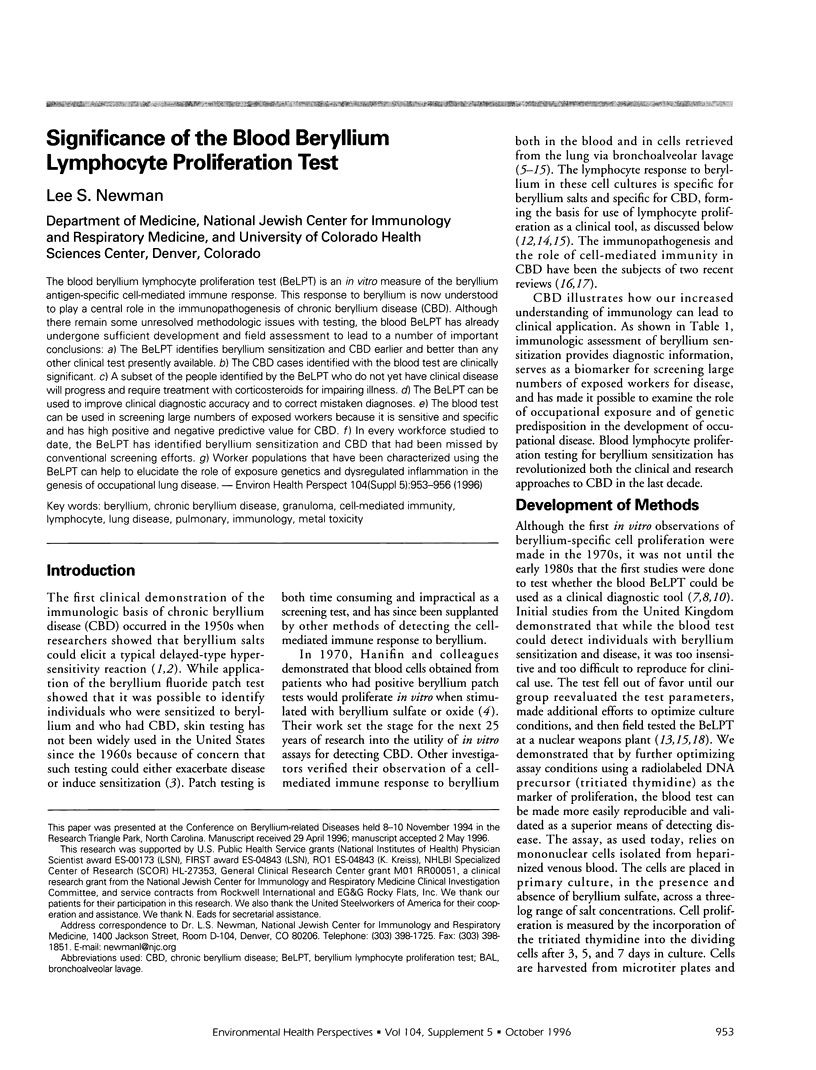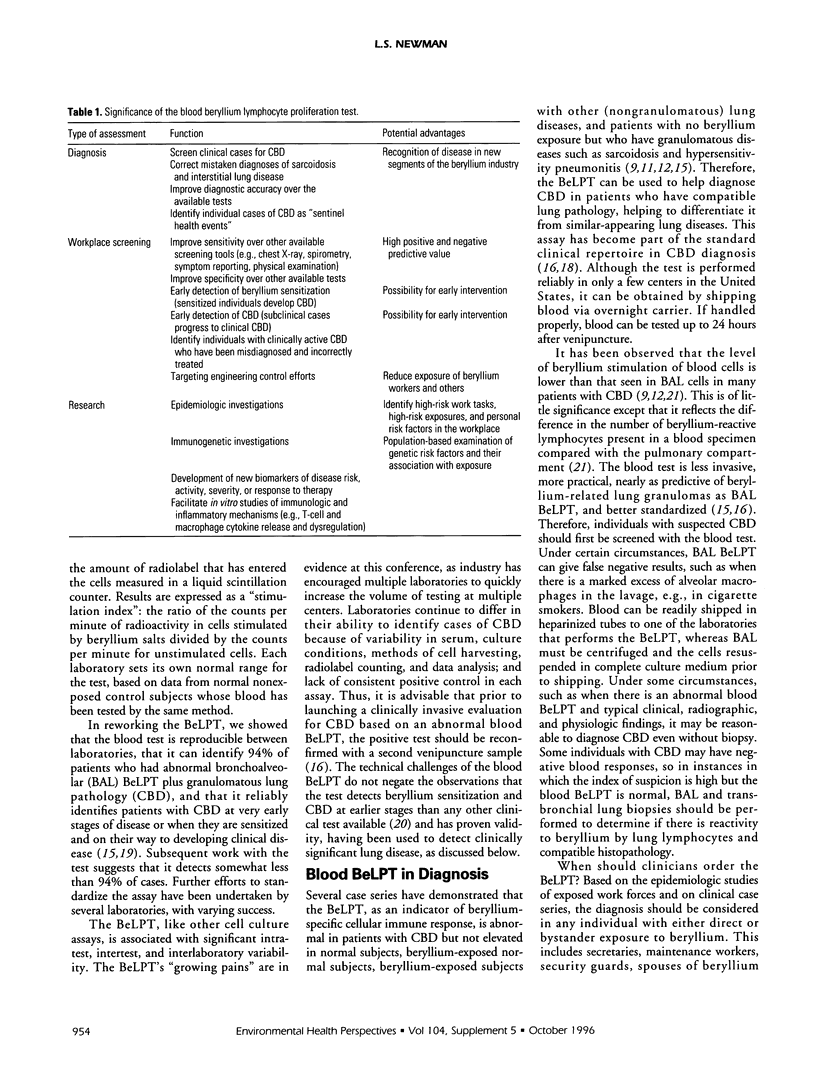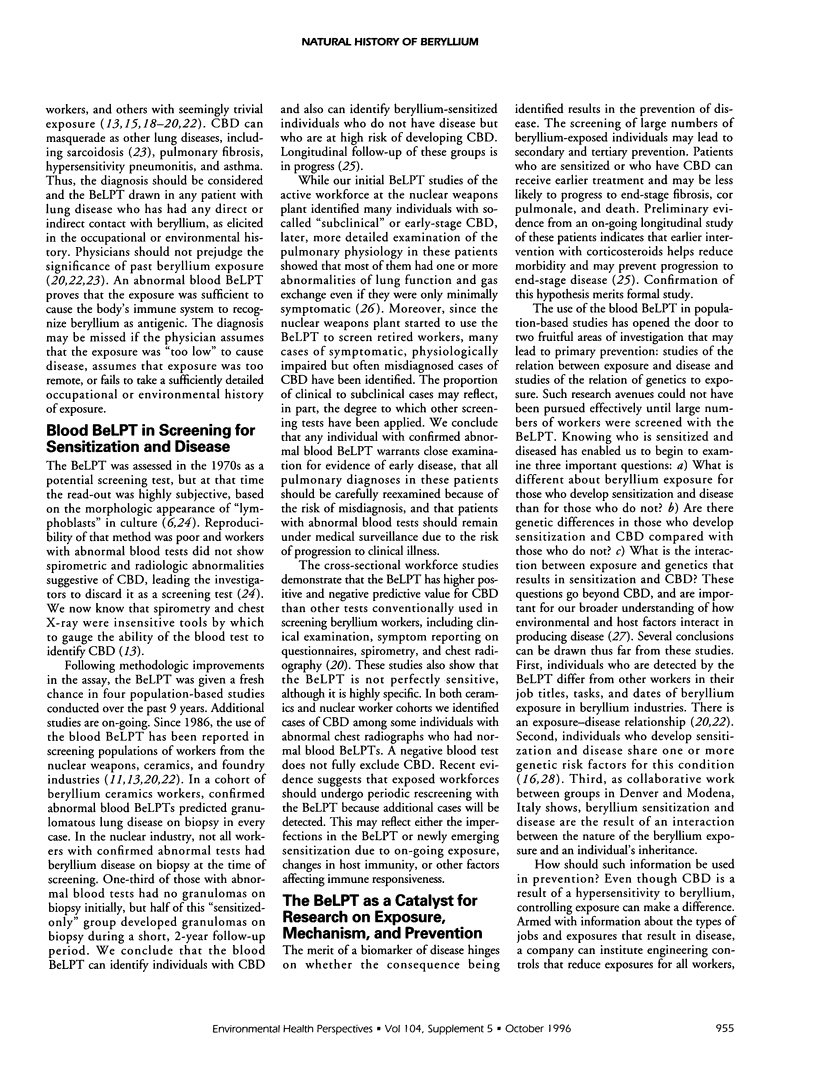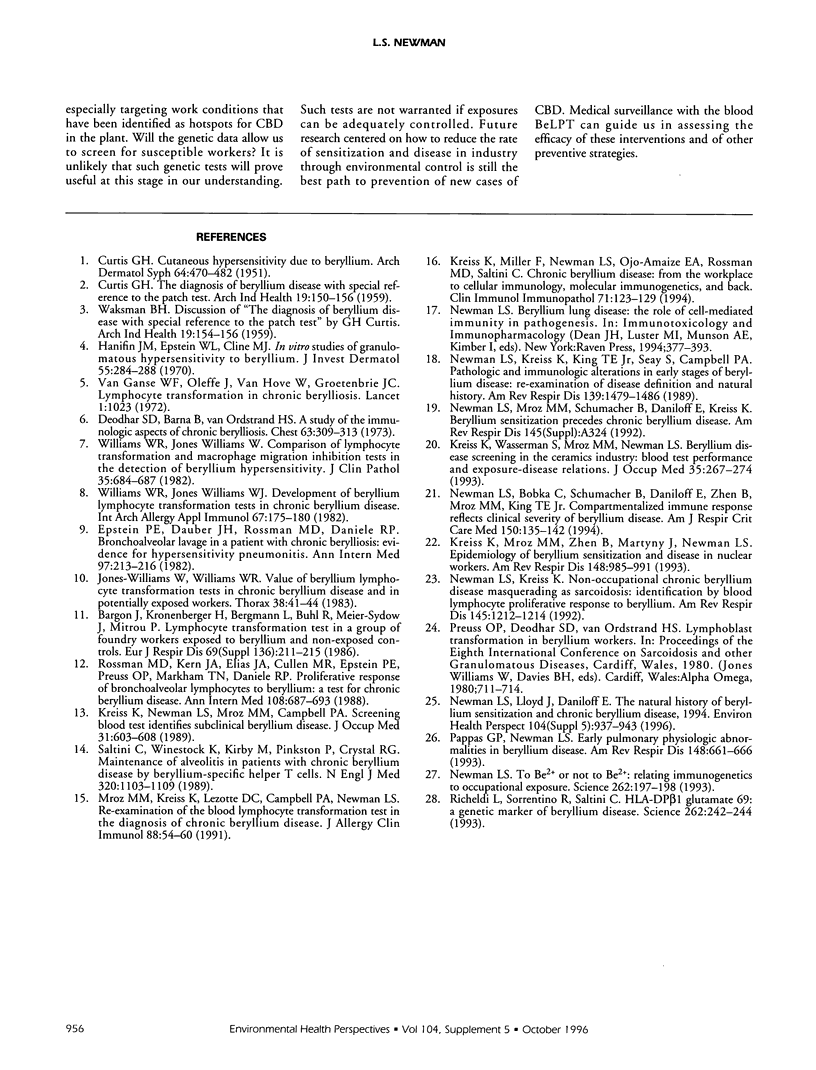Abstract
The blood beryllium lymphocyte proliferation test (BeLPT) is an in vitro measure of the beryllium antigen-specific cell-mediated immune response. This response to beryllium is now understood to play a central role in the immunopathogenesis of chronic beryllium disease (CBD). Although there remain some unresolved methodologic issues with testing, the blood BeLPT has already undergone sufficient development and field assessment to lead to a number of important conclusions: a) The BeLPT identifies beryllium sensitization and CBD earlier and better than any other clinical test presently available. b) The CBD cases identified with the blood test are clinically significant. c) A subset of the people identified by the BeLPT who do not yet have clinical disease will progress and require treatment with corticosteroids for impairing illness. d) The BeLPT can be used to improve clinical diagnostic accuracy and to correct mistaken diagnoses. e) The blood test can be used in screening large numbers of exposed workers because it is sensitive and specific and has high positive and negative predictive value for CBD. f) In every workforce studied to date, the BeLPT has identified beryllium sensitization and CBD that had been missed by conventional screening efforts. g) Worker populations that have been characterized using the BeLPT can help to elucidate the role of exposure genetics and dysregulated inflammation in the genesis of occupational lung disease.
Full text
PDF



Selected References
These references are in PubMed. This may not be the complete list of references from this article.
- Bargon J., Kronenberger H., Bergmann L., Buhl R., Meier-Sydow J., Mitrou P. Lymphocyte transformation test in a group of foundry workers exposed to beryllium and non-exposed controls. Eur J Respir Dis Suppl. 1986;146:211–215. [PubMed] [Google Scholar]
- CURTIS G. H. Cutaneous hypersensitivity due to beryllium; a study of thirteen cases. AMA Arch Derm Syphilol. 1951 Oct;64(4):470–482. doi: 10.1001/archderm.1951.01570100087014. [DOI] [PubMed] [Google Scholar]
- CURTIS G. H. The diagnosis of beryllium disease, with special reference to the patch test. AMA Arch Ind Health. 1959 Feb;19(2):150–153. [PubMed] [Google Scholar]
- Deodhar S. D., Barna B., Van Ordstrand H. S. A study of the immunologic aspects of chronic berylliosis. Chest. 1973 Mar;63(3):309–313. doi: 10.1378/chest.63.3.309. [DOI] [PubMed] [Google Scholar]
- Epstein P. E., Dauber J. H., Rossman M. D., Daniele R. P. Bronchoalveolar lavage in a patient with chronic berylliosis: evidence for hypersensitivity pneumonitis. Ann Intern Med. 1982 Aug;97(2):213–216. doi: 10.7326/0003-4819-97-2-213. [DOI] [PubMed] [Google Scholar]
- Hanifin J. M., Epstein W. L., Cline M. J. In vitro studies on granulomatous hypersensitivity to beryllium. J Invest Dermatol. 1970 Oct;55(4):284–288. doi: 10.1111/1523-1747.ep12260036. [DOI] [PubMed] [Google Scholar]
- Kreiss K., Miller F., Newman L. S., Ojo-Amaize E. A., Rossman M. D., Saltini C. Chronic beryllium disease--from the workplace to cellular immunology, molecular immunogenetics, and back. Clin Immunol Immunopathol. 1994 May;71(2):123–129. doi: 10.1006/clin.1994.1061. [DOI] [PubMed] [Google Scholar]
- Kreiss K., Mroz M. M., Zhen B., Martyny J. W., Newman L. S. Epidemiology of beryllium sensitization and disease in nuclear workers. Am Rev Respir Dis. 1993 Oct;148(4 Pt 1):985–991. doi: 10.1164/ajrccm/148.4_Pt_1.985. [DOI] [PubMed] [Google Scholar]
- Kreiss K., Newman L. S., Mroz M. M., Campbell P. A. Screening blood test identifies subclinical beryllium disease. J Occup Med. 1989 Jul;31(7):603–608. doi: 10.1097/00043764-198907000-00011. [DOI] [PubMed] [Google Scholar]
- Kreiss K., Wasserman S., Mroz M. M., Newman L. S. Beryllium disease screening in the ceramics industry. Blood lymphocyte test performance and exposure-disease relations. J Occup Med. 1993 Mar;35(3):267–274. [PubMed] [Google Scholar]
- Mroz M. M., Kreiss K., Lezotte D. C., Campbell P. A., Newman L. S. Reexamination of the blood lymphocyte transformation test in the diagnosis of chronic beryllium disease. J Allergy Clin Immunol. 1991 Jul;88(1):54–60. doi: 10.1016/0091-6749(91)90300-d. [DOI] [PubMed] [Google Scholar]
- Newman L. S., Bobka C., Schumacher B., Daniloff E., Zhen B., Mroz M. M., King T. E., Jr Compartmentalized immune response reflects clinical severity of beryllium disease. Am J Respir Crit Care Med. 1994 Jul;150(1):135–142. doi: 10.1164/ajrccm.150.1.8025739. [DOI] [PubMed] [Google Scholar]
- Newman L. S., Kreiss K., King T. E., Jr, Seay S., Campbell P. A. Pathologic and immunologic alterations in early stages of beryllium disease. Re-examination of disease definition and natural history. Am Rev Respir Dis. 1989 Jun;139(6):1479–1486. doi: 10.1164/ajrccm/139.6.1479. [DOI] [PubMed] [Google Scholar]
- Newman L. S., Kreiss K. Nonoccupational beryllium disease masquerading as sarcoidosis: identification by blood lymphocyte proliferative response to beryllium. Am Rev Respir Dis. 1992 May;145(5):1212–1214. doi: 10.1164/ajrccm/145.5.1212. [DOI] [PubMed] [Google Scholar]
- Newman L. S., Lloyd J., Daniloff E. The natural history of beryllium sensitization and chronic beryllium disease. Environ Health Perspect. 1996 Oct;104 (Suppl 5):937–943. doi: 10.1289/ehp.96104s5937. [DOI] [PMC free article] [PubMed] [Google Scholar]
- Newman L. S. To Be2+ or not to Be2+: immunogenetics and occupational exposure. Science. 1993 Oct 8;262(5131):197–198. doi: 10.1126/science.8105535. [DOI] [PubMed] [Google Scholar]
- Pappas G. P., Newman L. S. Early pulmonary physiologic abnormalities in beryllium disease. Am Rev Respir Dis. 1993 Sep;148(3):661–666. doi: 10.1164/ajrccm/148.3.661. [DOI] [PubMed] [Google Scholar]
- Richeldi L., Sorrentino R., Saltini C. HLA-DPB1 glutamate 69: a genetic marker of beryllium disease. Science. 1993 Oct 8;262(5131):242–244. doi: 10.1126/science.8105536. [DOI] [PubMed] [Google Scholar]
- Rossman M. D., Kern J. A., Elias J. A., Cullen M. R., Epstein P. E., Preuss O. P., Markham T. N., Daniele R. P. Proliferative response of bronchoalveolar lymphocytes to beryllium. A test for chronic beryllium disease. Ann Intern Med. 1988 May;108(5):687–693. doi: 10.7326/0003-4819-108-5-687. [DOI] [PubMed] [Google Scholar]
- Saltini C., Winestock K., Kirby M., Pinkston P., Crystal R. G. Maintenance of alveolitis in patients with chronic beryllium disease by beryllium-specific helper T cells. N Engl J Med. 1989 Apr 27;320(17):1103–1109. doi: 10.1056/NEJM198904273201702. [DOI] [PubMed] [Google Scholar]
- Van Ganse W. F., Oleffe J., Van Hove W., Groetenbriel C. Lymphocyte transformation in chronic pulmonary berylliosis. Lancet. 1972 May 6;1(7758):1023–1023. doi: 10.1016/s0140-6736(72)91204-4. [DOI] [PubMed] [Google Scholar]
- WAKSMAN B. H. The diagnosis of beryllium disease, with special reference to the patch test; discussion of paper by Dr. Curtis. AMA Arch Ind Health. 1959 Feb;19(2):154–156. [PubMed] [Google Scholar]
- Williams W. J., Williams W. R. Value of beryllium lymphocyte transformation tests in chronic beryllium disease and in potentially exposed workers. Thorax. 1983 Jan;38(1):41–44. doi: 10.1136/thx.38.1.41. [DOI] [PMC free article] [PubMed] [Google Scholar]
- Williams W. R., Williams W. J. Comparison of lymphocyte transformation and macrophage migration inhibition tests in the detection of beryllium hypersensitivity. J Clin Pathol. 1982 Jun;35(6):684–687. doi: 10.1136/jcp.35.6.684. [DOI] [PMC free article] [PubMed] [Google Scholar]
- Williams W. R., Williams W. J. Development of beryllium lymphocyte transformation tests in chronic beryllium disease. Int Arch Allergy Appl Immunol. 1982;67(2):175–180. doi: 10.1159/000233010. [DOI] [PubMed] [Google Scholar]


